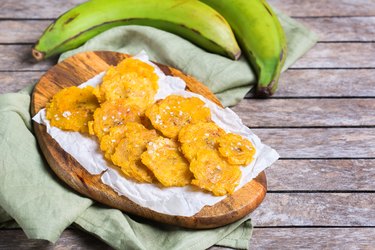
Despite the thousands of items lining supermarket shelves, most of us purchase the same products again and again... and again. While there's nothing wrong with tried-and-true staples, health experts agree there are a number of good reasons to change up the contents of our shopping carts.
For one, people who eat more than 30 different types of plant-based foods weekly have significantly more diversity in the makeup of their gut microbiome compared to those who have fewer than 10 plant-based foods weekly, according to a May 2018 study in mSystems. A greater variety of good gut bugs helps promote better immune function and digestion.
Video of the Day
Video of the Day
Broadening the scope of our grocery lists also encourages us to try less familiar ingredients from other parts of the world. Because berries and salmon aren't the only superfoods out there (gasp!).
Just ask Zariel Grullón, RD, dietitian and co-founder of Love Your Chichos and Radicare, who says trying foods from cultures other than our own is not only nutritious, but also a valuable learning opportunity.
"It's important to acknowledge the history behind [a new] food and learn about how it's traditionally prepared," Grullón says. "We also want to be respectful when trying new foods… and to not yuck other cultures' yums!"
Below, registered dietitians highlight nine good-for-you global foods you should be eating if you aren't already.
1. Breadfruit
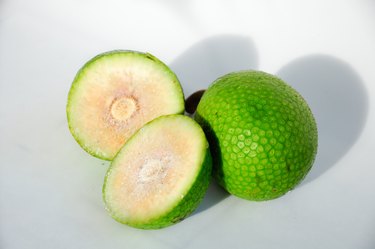
- 11 grams of fiber per cup (that's about 50 percent of your daily fiber needs)
- Great source of potassium, a critical electrolyte involved in fluid balance and blood pressure regulation
- Good source of immune-supportive vitamin C
"This starchy fruit, which comes into season two to three times per year in Trinidad and Tobago, can be enjoyed steamed, roasted, boiled or even raw when ripe," says Amber Charles-Alexis, MSPH, RDN, registered dietitian and founder of The Cultural Dietitian.
Breadfruit is best known for its role in dishes like Oil Down, which is "a one-pot dish that can be made with boiled breadfruit, taro leaves, pumpkin, herbs and spices, coconut milk and a protein like chicken, pork or fish," Charles-Alexis explains. It can also be found in casseroles like pone, as well as salads and curries. Throughout the year, breadfruit flour can be used to prepare baked goods.
Hungry for more information about breadfruit? Check out Charles-Alexis's Caribbean market recap on the nourishing ingredient.
2. Culantro
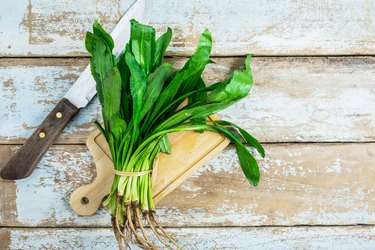
- Good source of antioxidant vitamins A and C
- Contains calcium, a key mineral for heart and muscle function
- Linked to helping treat the flu, fever and constipation, per Purdue University
"Cilantro ancho, also known as 'culantro' or 'recao,' is an ingredent used in many Dominican dishes," Grullón explains. "The herb is similar to cilantro but much stronger in flavor." It's also the main ingredient in sofrito, a flavor-rich blend of herbs, vegetables and spices that are used as the base in many Dominican dishes.
"Besides being used in sofrito, culantro can also be added to soups, stews and rice dishes," Grullón says. Just be warned: If cilantro tastes soapy to you, culantro will too — and the flavor may be even stronger.
Sofrito Around the World
Sofrito is also a staple in Mediterranean cooking, says Annamaria Louloudis, RD, a registered dietitian at Culina Health. “A Mediterranean sofrito typically consists of garlic, onion, peppers and tomatoes cooked in olive oil with herbs and spices, like bay leaves.”
Research on sofrito suggests that the combination of slow cooking vegetables and using olive oil may enhance the activity of the ingredients' antioxidants, which could contribute to lower heart disease and cancer risk if enjoyed consistently over time, Louloudis says.
3. Eddo Leaf Bhaji

- High in potassium, folate and vitamins A and C
- Low in carbohydrates and calories
"The leaves of the root vegetable eddo are a favorite staple in Guyana," says Naudia Jones, RD, a registered dietitian at Culina Health. "Eddo is very similar to root vegetables like taro, also known as malanga."
Eddo leaf, which is similar to spinach, is commonly enjoyed sautéed with garlic and onions in a coconut milk broth. "This dish is often served during Hindu ceremonies and weddings alongside dhal and rice," Jones says.
Interested in trying eddo? "Both eddo and eddo leaf can be found at local vegetable stores in neighborhoods that have large Bengali and Guyanese populations," Jones tells LIVESTRONG.com. She regularly buys the ingredient at markets in the Little Guyana neighborhood in Ozone Park, Queens.
Tip
Due to the high oxalate content in raw eddo leaf, this ingredient must be eaten cooked.
4. Plantains
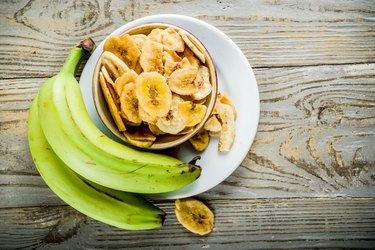
- Great source of prebiotic resistant starch, which supports gut health by promoting the growth of good bacteria in the intestines
- Rich source of minerals like potassium and magnesium, both of which play a role in blood pressure regulation, per Harvard Health Publishing
A starchy fruit with roots in Africa and East Asia, plantains are a versatile ingredient that can be eaten at any meal of the day.
"Just like potatoes, plátanos [plantains] can be enjoyed in many ways and at all stages of ripeness," Grullón explains. Unripe, green plantains are ideal for savory dishes, while ripe (think: yellow or even black) plantains are perfect for sweeter recipes.
"My favorite way to enjoy plátanos for breakfast is as a mangú, a dish of mashed plantains that's typically served with pickled onions and fried eggs, as well as fried salchichon and fried cheese if you're really going [for it]," Grullón says. "Plátano maduros — also known as ripe plantains — are delicious as a pastelón."
If you're in the mood for some crunch, tostones are another great way to put plantains into your recipe rotation.
5. Chapulines (Grasshoppers)
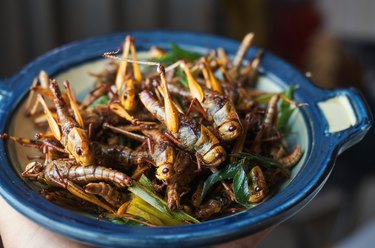
- Great source of eco-friendly protein
- The R. nitidula variety of grasshopper provides fiber, potassium and phosphorous, per a January 2017 paper in Food Science & Nutrition
Entomophagy — that is, the act of eating insects — isn't a pillar of the Western diet, but that doesn't mean it's not common. In fact, it's estimated that some 2 billion people worldwide regularly include critters in their diet, according to a 2013 report by the Food and Agriculture Organization.
Grasshoppers, also known as chapulines, are a mainstay in Mexican cooking. "Typically [the bugs] are roasted with lemon and salt for an excellent, crispy snack," Paula Rubello, RD, a registered dietitian at Culina Health says. "Another classic way to consume grasshoppers is in tacos with guacamole."
If eating whole insects isn't your thing, Rubello recommends blending cricket protein powder into smoothies to start.
6. Dandelion Greens

- Excellent source of vitamins A, E, K and folate (1 cup of cooked dandelion greens delivers 482 percent of your daily vitamin K needs)
- Serves up minerals like iron, potassium and magnesium
- Contains inulin, a prebiotic fiber that supports a healthy gut microbiome
Dandelion greens aren't typically sold in the supermarket, but that doesn't mean you aren't familiar with the leafy green. The wild plant often grows on the side of roads or even in backyard lawns.
Don't dismiss dandelion greens as a pesky weed, though. "Dandelion greens are full of antioxidants that can fight inflammation and help prevent chronic disease," Louloudis says.
Tip
Keep an eye out for dandelion greens at your local farmers' market when they're in season from early spring to late fall. The leafy greens are best enjoyed simply: boiled and served with lemon juice and extra-virgin olive oil, Louloudis says.
7. Huitlacoche (Corn Mushroom)
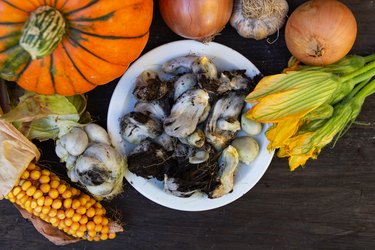
- Good source of unsaturated fatty acids and essential amino acids like lysine
- Contains fiber and antioxidants like vitamin C, per a July 2022 paper in Food Chemistry: Molecular Sciences
"Sometimes called the 'Mexican truffle' or 'Aztec caviar,' huitlacoche is actually a fungus that grows on corn," Rubello says.
Use huitlacoche as you would any other mushroom. "In Mexico, it's typically eaten in a quesadilla along with oaxaca cheese," Rubello explains.
Try this corn truffle quesadilla recipe to learn how to make them at home.
Tip
You can find canned huitlacoche online ($10, Amazon) or look out for the ingredient at your grocery store or local Mexican market ahead of your next taco Tuesday.
8. Acerola Cherries
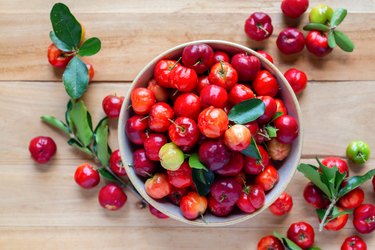
- Excellent source of immune-supportive vitamin C (1 cup of acerola cherries provides more than 1,800 percent of your daily vitamin C needs)
Also known as Guyanese or Barbados cherries, these small stone fruits are juicy, tangy and fragrant, Jones says. "In Guyana, the cherries are typically enjoyed fresh, in marmalades, juiced or in ice pops or smoothies."
In the states, you can find acerola cherries in powdered form on Amazon ($23.99) and add the ingredient to smoothies. Looking for another way to enjoy the flavorful fruit? Try this acerola cherry salsa.
The Bottom Line
"Eating a variety of foods, especially plant-based foods, helps us consume a variety of micronutrients and antioxidants that support everything from eye, heart, bone and skin health to immune system function," Louloudis says.
Extra credit goes to those who seek out superfoods from other parts of the world. Despite what the mainstream media may tell us, every culture cooks up nourishing fare. All we need to do is seek it out.
- USDA Food Data Central: “Breadfruit, Raw”
- mSystems: “American Gut: an Open Platform for Citizen Science Microbiome Research”
- Chef Zee Cooks: “Sofrito: The Secret to Hispanic Caribbean Cooking”
- My Dominican Kitchen: “Pastelón de Plátano Maduro (Sweet Plantains and Picadillo Casserole)
- Food Chemistry: “Bioactive Compounds Present in Mediterranean Sofrito”
- The Cultural Dietitian: “Caribbean Market: Dasheen Bush”
- Cooking with Ria: “Saheena: Spinach Fritter”
- Harvard Medical School: “Key Minerals to Help Control Blood Pressure”
- Dominican Cooking: “Mangu (Dominican Mashed Plantains)”
- Sofrito Project: “Tostones (Twice-Fried Plantains)”
- Food Science & Nutrition: “Nutritional Composition, Quality, and Shelf Stability of Processed Ruspolia Nitidula (Edible Grasshoppers)”
- Food and Agriculture Organization: “Edible Insects: Future Prospects for Food and Feed Security”
- My Food Data: “Cooked Dandelion Greens”
- Food Chemistry: “Bioactive Ingredients of Huitlacoche (Ustilago maydis), a Potential Food Raw Material”
- My Food Data: “Acerola Cherries”
- Mexican Made Meatless: “Corn Truffle Quesadillas”
- National Institutes of Health: “Health Professional Fact Sheet: Vitamin C”
- Purdue University: “Culantro: A Much Utilized, Little Understood Herb”
- Check Your Food: “Acerola Cherry Salsa”


